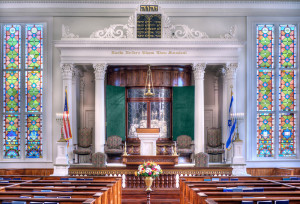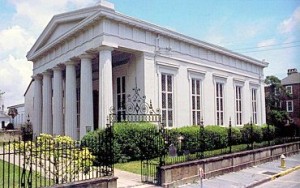History of Kahal Kadosh Beth Elohim (KKBE)
90 Hasell Street
Charleston, SC
The history of Kahal Kadosh Beth Elohim is a heritage in which all American Jews can take pride. It is a story of faith, devotion, and perseverance in the American tradition of freedom
of worship.
Charleston was founded in 1670, and the earliest known reference to a Jew in the English settlement is a description dated 1695. Soon thereafter other Jews followed, attracted by the civil and religious liberty of South Carolina and the ample economic opportunity of the colony. These pioneers were sufficiently numerous by 1749 to organize the present congregation, Kahal Kadosh Beth Elohim, (Holy Congregation House of God) and, fifteen years later, to establish the now historic Coming Street Cemetery, the oldest surviving Jewish burial ground in the South.
KKBE is the fourth oldest Jewish congregation in the continental United States (after New York, Newport and Savannah). At first, prayers were recited in private quarters and from 1775, in an improvised synagogue adjacent to the present-day grounds. In 1792, construction of the largest and most impressive synagogue in the United States was commenced. It was dedicated two years later. A member of the visiting Lafayette’s entourage is reported to have described the building as “spacious and elegant.” This handsome, cupolated Georgian synagogue was destroyed in the great Charleston fire of 1838 and replaced in 1840 on the same Hasell Street site by the structure in use today. The colonnaded building, dedicated in early 1841 is often described as one of the country’s finest examples of Greek Revival architecture. On this occasion, KKBE’s Reverend Gustavus Poznanski was moved to say, “This synagogue is our Temple, this city our Jerusalem, and this happy land our Palestine.”
Today, KKBE has the second oldest synagogue building In the United States and the oldest in continuous use. It was designated a National Historic Landmark in 1980.
Birthplace of Reform
Charleston is acknowledged as the birthplace of Reform Judaism in the United States. In 1824, 47 congregants petitioned the Adjunta (the trustees) of the synagogue to change the Sephardic Orthodox liturgy. The petition, which asked for abridgement of the Hebrew ritual, English translation of the prayers, and a sermon in English, was denied. The disappointed liberal members thereupon resigned from the congregation and organized “The Reformed Society of Israelites”. This independent society, led by Isaac Harby and Abraham Moise was influenced by the ideas of the Hamburg Reform congregation, the leading modernist community in Europe. It lasted only nine years, but many of its practices and principles have become part of today’s Reform Judaism The Progressives rejoined the old congregation, and while the present temple was being built in 1840, an organ was installed. As well as the organ, the first service in the new temple introduced a liberalized ritual. KKBE was one of the founding synagogues of the Union of American Hebrew Congregations in1873, (now Union for Reform Judaism, URJ), and remains firmly and proudly committed to Reform Judaism.
Leadership
For almost two and a half centuries members of KKBE have been eminent leaders in the city, state and country. Among notable early congregants were Moses Lindo, who before the Revolution helped to develop the cultivation of Indigo (then South Carolina’s second crop) and Joseph Levy, veteran of the Cherokee War of 1760-61 and probably the first Jewish military officer in America. Almost two dozen men of Beth Elohim served in the War of Independence, among them the brilliant young Francis Salvador, who as delegate to the South Carolina Provincial Congresses of 1775 and 1776, was the first Jew to serve in an American legislature. Killed shortly after the signing of the Declaration of Independence, Salvador was also the first Jew known to die in the Revolutionary War.
Members of the congregation founded Charleston’s Hebrew Benevolent Society in 1784, the nation’s oldest Jewish charitable organization, and in 1801 established the Hebrew Orphan Society, also the country’s oldest. Both are still active. In 1838 the second oldest Jewish Sunday school in the United States was organized, The blind poet, Penina Moise, was a famous early superintendent.
Other congregants pioneered in steamship navigation, introduced illuminating gas to American cities, and numbered four of the eleven founders of the country’s Supreme Council of Scottish Rite Masonry.
In 1790, President George Washington responded to a letter of congratulations to him by writing, “The affectionate expressions of your address again excite my gratitude, and receive my warmest acknowledgment. May the same temporal and eternal blessing which you implore for me, rest upon your Congregation.” A replica of this letter can be viewed in the KKBE Museum.
The Synagogue
 This outstanding Greek Revival style building was constructed in 1840 by member David Lopez from a design by architects Tappan and Noble and work plans by C. L.Warner. It replaces a 1794 cupolated Georgian style structure destroyed by fire in 1838. The temple grounds are fronted by a graceful iron fence dating from the 1794 synagogue. Also surviving are the bases of two menorahs (candelabras) on either side of the Bimah. The large marble tablet above the huge entrance doors proclaims the Sh’ma in Hebrew and an unusual English translation: “Hear O Israel the Lord Our God is the sole Eternal Being.” In the foyer over the entrance to the sanctuary is the original dedication stone from the 1794 synagogue. When our current building was erected in 1840, a controversial organ was installed in the balcony at the rear of the sanctuary. Housing our four Torah scrolls is the massive ark made of Santo Domingo mahogany. The stained glass windows, which show Jewish religious symbols, date from 1886 and are replacements of windows destroyed in the earthquake of that year. The interior of the synagogue, originally following a traditional Sephardic Orthodox arrangement, was altered first in 1879 with the installation of family pews and the removal of the pulpit to the front of the sanctuary. Then, in 1886, after the earthquake, balconies on both sides of the building were removed and the Bimah reconfigured.
This outstanding Greek Revival style building was constructed in 1840 by member David Lopez from a design by architects Tappan and Noble and work plans by C. L.Warner. It replaces a 1794 cupolated Georgian style structure destroyed by fire in 1838. The temple grounds are fronted by a graceful iron fence dating from the 1794 synagogue. Also surviving are the bases of two menorahs (candelabras) on either side of the Bimah. The large marble tablet above the huge entrance doors proclaims the Sh’ma in Hebrew and an unusual English translation: “Hear O Israel the Lord Our God is the sole Eternal Being.” In the foyer over the entrance to the sanctuary is the original dedication stone from the 1794 synagogue. When our current building was erected in 1840, a controversial organ was installed in the balcony at the rear of the sanctuary. Housing our four Torah scrolls is the massive ark made of Santo Domingo mahogany. The stained glass windows, which show Jewish religious symbols, date from 1886 and are replacements of windows destroyed in the earthquake of that year. The interior of the synagogue, originally following a traditional Sephardic Orthodox arrangement, was altered first in 1879 with the installation of family pews and the removal of the pulpit to the front of the sanctuary. Then, in 1886, after the earthquake, balconies on both sides of the building were removed and the Bimah reconfigured.
In 2003, the Congregation received the prestigious Carolopolis Award for exterior preservation.
Pearlstine Family Building
Parallel to the length of the Temple stands the building formerly called the Bicentennial Tabernacle, which was erected in 1950 during the 200th anniversary celebration of the congregation. This building replaced the temporary structure built after the 1838 fire. The Tabernacle was renovated and expanded in 2001-03 and renamed the Pearlstine Family building. The current building houses the religious school, our administrative office, the Chosen Treasures Judaica & Gift Shop, the spacious Barbara Pearlstine Social Hall and the kitchen. The original cornerstones are located over the entranceway into Barbara Pearlstine Hall. In the Social Hall two large murals painted by Charleston artist William Halsey, a former congregant, portray founders and patriots of the congregation.There are also a pair of wrought iron sculptures of Biblical prophets by the late Willard Hirsch.
The Heyman Building
The reconditioned and expanded 18th century residence to the rear of the Temple at 86 Hasell Street contains a youth lounge and supplemental meeting and classrooms.
Our Cemeteries
Coming Street Cemetery KKBE’s Coming Street Cemetery (190-195 Coming Street) is the oldest surviving Jewish cemetery in the South. It is listed on the National Register of Historic Places.
Buried here are:
- Ten congregants who fought in the American Revolution,
- Six soldiers of the War of 1812,
- Two soldiers in the Seminole Wars in Florida,
- 21 Civil War participants, of whom eight died in the Confederate cause,
- Six Rabbis of the congregation,
- 18 Past presidents of the congregation.
- Four of the eleven founders of the Supreme Council of Scottish Rite Masonry in 1801.
Bronze plaques placed on some tombstones in 1964 identify notable personages. Except for a few family plots, all present day burials occur in Beth Elohim’s Huguenin Avenue Cemetery, which was established in 1887. When this site was first used as a cemetery, it was outside the then city limits at Calhoun Street.
The Coming Street Cemetery has three sections:
A. This area is the original congregational cemetery and dates from 1764; from 1754; it was the DaCosta family plot.
B. This part was developed by members of Beth Elohim who had seceded in 1841 over the installation of an organ in the synagogue and had formed Orthodox Congregation Shearit Israel. When the two congregations merged after the Civil War, a dividing wall was taken down.
C. The Lopez family plot was established in the 1843 when Shearit Israel refused burial to David Lopez’s first wife who had not been converted to Judaism. The Cemetery contains over 500 graves; many are not marked. The oldest identifiable grave is that of Moses D. Cohen, the first religious leader of Beth Elohim, who died in 1762.
Visitation to the Coming Street Cemetery must be made by appointment. Call 843-723-1090. To see index of cemetery burials click here.
Huguenin Avenue Cemetery K.K.B.E.’s Huguenin Avenue Cemetery is its present burial ground. It was first developed on land, which then abutted the northern limit of the City of Charleston. It was purchased from the Washington Light Infantry in l887.
The cemetery was expanded in l991 on property bought from the Standard Oil Company in 1943. It contains the remains of persons buried since l888, also remains and stones which were removed from three defunct graveyards: the Dacosta (l783-l939) and Harby (1799-1939) cemeteries on Hanover Street, and the Rikersville Cemetery (1857-1888), which had been established by Congregation Shearit Israel).
To see a list of the burials in the Huguenin Avenue Cemetery click here.
To see a list of the burials in the Coming Street Cemetery click here.
On July 1, 2010, Rabbi Stephanie Alexander became the first woman Rabbi of Kahal Kadosh Beth Elohim. At the same time, Rabbi Anthony D. Holz, retired and became Rabbi Emeritus.
Click here to watch a video on KKBE’s history, narrated by volunteer docent T.R. Williams.
History acquired from KKBE website – kkbe.org
